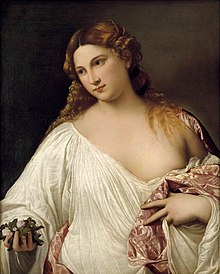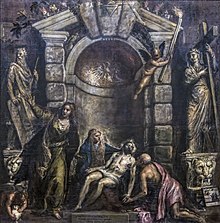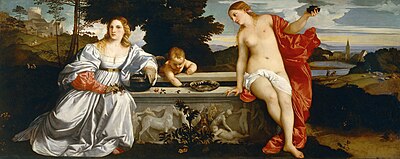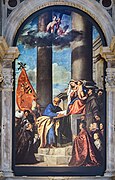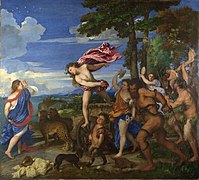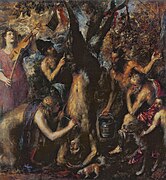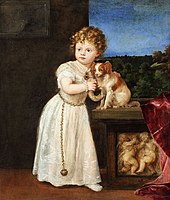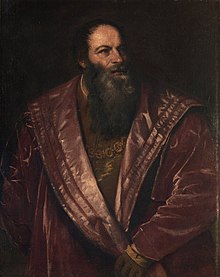Titian
Tiziano Vecellio di Gregorio, traditionally known in Spanish as Tiziano or Titiano (Pieve di Cadore, Belluno, Veneto, circa 1488/1490 -Venice, August 27, 1576), was an Italian painter of the Renaissance, one of the greatest exponents of the Venetian School.
Recognized by his contemporaries as "the sun among the stars", in homage to the final line of Paradise from Dante Alighieri's The Divine Comedy, Titian is one of the most versatile Italian painters, equally capable of executing portraits, landscapes (two of the themes that launched him to fame), mythological scenes or religious-themed paintings. He had a long and drawn-out career, and his work went through many different stages, in which his style changed so drastically that some critics have trouble believing that the paintings of his early and subsequent stages came from the same hand.
In any case, his work as a whole is characterized by the use of color, vivid and luminous, with a loose brushstroke and a delicacy in chromatic modulations unprecedented in the History of Western Art.
Biography
Early years (until 1516)

If Titian's birthplace is known with certainty, the date is unknown. There are three hypotheses based on the documents of the time. According to his death certificate, which is kept in the Venetian church of San Canciano, the artist died at the "age of one hundred and three years", so his birth would be dated to 1473. On the other hand, in Titian's correspondence to Felipe II of 1571, the painter introduces himself as "this servant of yours ninety-five years of age", we can therefore deduce that he was born in 1476. His contemporaries Ludovico Dolce and Giorgio Vasari estimate that the date would be between 1488 and 1490. Given these differences, international criticism is divided. Historians Harold Wethey and Sydney Freedberg believe that the birth between 1488 and 1490 is more reliable. The Center for Titian Studies and other authors determine that it must have occurred between 1480 and 1485, discarding other dates due to their precocity being too suspicious in their opinion. of some early works. This last opinion is the most consolidated. The reason for the erroneous date in the letter to the Spanish king may have been that the artist intended to present himself as a venerable old man in order to elicit the monarch's compassion.
Tiziano came from a family with high status in Cadore: he was the fourth child of Gregorio Vecelli, a distinguished councilor and soldier, and his wife Lucia. There was no family history in the field of art. However, at the age of 10, Titian and his older brother, Francesco, went to Venice to apprentice in the workshop of Sebastiano Zuccato, a famous mosaic artist. Due to his budding talent, over the course of three or four years, he entered the studio of the venerable painter Giovanni Bellini, who was at the time the most recognized artist in the city. There he met a group of young people who would make up the first generation of painters of the Venetian School: Giovanni Palma da Serinalta, Lorenzo Lotto, Sebastiano Luciani, and Giorgio da Castelfranco, known as Giorgione. His brother Francesco his also enjoyed some relevance in Venice as a painter.
The fresco on Hercules in the Morosini palace is considered one of his first creations. Other early works are the Virgin and Child from the Belvedere Palace in Vienna and the Visitation of Mary to Elizabeth (from the convent of Saint Andrew), on display today at the Gallery of the Venice Academy. Titian and Giorgione, at this time, were associated, hence the difficulty of distinguishing his early works. Titian's first known work, the small Ecce Homo from the School of San Roque, was long attributed to Giorgione. The same identification confusion occurs with more than some of his Sacra conversazione. These two masters were the leaders of the new school of "modern art" of painting, which acquired more flexible modes of execution, free from the symmetry and hieraticism that we can still observe in the work of Giovanni Bellini.
From 1507 to 1508, Giorgione was commissioned to remodel the Fondaco dei Tedeschi, a market for powerful German merchants in the Adriatic city. Titian and Morto da Feltre collaborated with him on the frescoes, some of Titian's fragments still extant. This work is known exactly due to the engravings by Domenico Fontana, since the frescoes are not fully preserved.
When the plague epidemic swept through Venice in 1510 and killed his companion Giorgione, Titian went to Padua, where he demonstrated his talent for the fresco technique in his works in this city in 1511, both in the church of the Carmelites as in the School of San Antonio. Some of these works are still preserved. Highlights include The embrace at the golden gate and three scenes from the life of Saint Anthony of Padua: The miracle of the newborn, The miracle of the jealous husband and The miracle of the irascible son.
In 1512, Titian returned from Padua to Venice, where he began to establish a network of relationships that would take him to the pinnacle of the Venetian group of artists. He soon obtained work from the Fondaco dei Tedeschi, obtained from it La Sanseria or Senseria (a privilege highly coveted by emerging artists), and became superintendent of government works, position of official painter of the Republic of Venice, which would bring him sufficient remuneration and other added privileges. Titian would hold it without interruption for sixty years, until his death. The commission to complete the decoration, unfinished by Bellini, of the Grand Council Room of the Ducal Palace (destroyed by fire in 1577) in which he would represent the Battle of Spoleto was especially moving. He opened his own workshop, near the Grand Canal at San Samuele, in a currently unknown location. In 1513, Cardinal Pietro Bembo extended the invitation of Pope Leo X to settle in Rome and, although the offer was tempting, he preferred to stay in Venice, where artistic competition was less intense than in the papal seat. It was not, however, until the death in 1516 of his teacher, Giovanni Bellini, that his prestige began to grow. At this time, he received a very exclusive commission that would bring him a remarkable twenty-crown annuity and exemption from certain fees. It was a series of portraits of the successive Doges of Venice, each being paid eight crowns. Titian made only five of this series.
Maturity (1516-1530)
During his long career, he became the most influential of the painters of the Venetian School, and the most laureate of the Most Serene Republic in its entire history. The deaths of Giorgione (1510) and Bellini (1516), and the transfers of Sebastiano del Piombo to Rome (1511) and of Lorenzo Lotto to Bergamo (1513), left Titian without rivals in the city.
During the period 1516-1530, which can be described as one of expansion, the artist freed himself from the hermetic canons learned during his youth and covered a greater number of themes. However, his portraits were a key element to introduce him to the most prestigious courts and meet the most powerful men of his time. Some of them, such as the lords of Mantua, Ferrara or Urbino, small Italian states threatened by the expansion of international powers, found in Titian's portraits an opportunity to demonstrate an image of power and glory, which perhaps did not correspond to reality. As early as 1518, the painter came into contact with Alfonso I d'Este, Duke of Ferrara. The series of portraits of the Estense court, today scattered around the world, constitute a revealing gallery of characters, feelings and situations.
In 1518 he completed, for the main altar of the Basilica of Santa Maria Gloriosa dei Frari in Venice, the Assumption of the Virgin, which still remains there. This extraordinary piece of colourism, executed in a large chromatic scale rarely used in Italy before, caused a sensation in his time.
The pictorial structure of the Assumption of the Virgin, which unified in the same composition two or three scenes superimposed on different levels, heaven and earth, the infinite and the temporal, was continued in other works. This series of canvases with the same formal structure includes the Altarpiece of San Domenico in Ancona (1520), the Altarpiece of Brescia (1522), and the Altarpiece of San Niccolo (1523), in Vatican City, each of which represents a greater and more perfect distributive conception. He finally came to create a classic formula, the best exponent of which is the Altarpiece or Pala of Pesaro (1526), in the Iglesia dei Frari itself. This is perhaps his most studied work of the period, in which he patiently developed a work plan based on free visualization, originality, and style. Titian gave the figures a new use, with the "donors" and the procession of saints located in the airspace of the scene, while the whole was framed by architectural elements. The Pesaro Altarpiece owes its name to Jacopo Pesaro, Bishop of Paphos, who commissioned it to commemorate the naval victory over the Turks at the Battle of Santa Maura.
Tiziano was at the height of his fame: around 1521, after the completion of a Saint Sebastian for the Papal Nunciature in Brescia —a work of which there are innumerable replicas— orders were piling up in his workshop.
Another extraordinary work belongs to this period, The Martyrdom of Saint Peter of Verona (1530), housed in the Dominican church of San Zanipolo and destroyed by an Austrian shell in 1867. This proto-Baroque work only it is known for copies, such as the one at the École des Beaux-Arts in Paris. The scene represents a curious association between a placid landscape and a brutal and dynamic murder, described by the lament that ascends through the oaks. The painting depicts the Dominican saint escaping from the ambush, and above this, the chilling black branches of the vegetation — «[...] this is all, but perhaps there has never been a tragedy as dynamic, astonishing and pathetic as this one, not even painted by Tintoretto or Delacroix".

The artist simultaneously continued with his series of small Madonnas, which he inserted into landscape scenes in the manner of painting in the poetic-pastoral genre, very fashionable at that time. The Virgin with Child, Saint John and Saint Catherine, known as the Virgin of the Rabbit, in the Louvre Museum is the prototype of this kind of canvas. Another example of religious painting from this period is the Burial of Christ, also in the Louvre. This was also the period of his best mythological paintings, such as La Bacchanal from the Museo del Prado or Bacchus and Ariadne from the National Gallery in London, «[...] perhaps the most brilliant productions of neo-pagan culture or "Alexandrismo" of the Renaissance, often imitated but never surpassed, not even by Rubens himself". >Woman looking in the mirror of the Louvre (in which an attempt has been made to recognize, without any historical rigor, Laura de Dianti or Titian's wife).
After several years of living together with a lady named Cecilia Soldano, in the course of which they had already had two children, Pomponio and Horacio (supposedly the painter's favorite son), in 1525, they decided to get married due to the poor health of her and to legitimize these children. Cecilia did not survive more than five years from this union, during which she brought two daughters into the world (some sources indicate three). One of them, Lavinia, would be immortalized in several paintings. Around 1526 she came into contact with the writer Pietro Aretino, with whom she had a close relationship, whose influence increased in successive years, according to the chronicles of the time. Titian even sent a portrait of Aretino to Federico II Gonzaga, Duke of Mantua. Titian's relationship with the court of Mantua began thanks to the recommendation of Alfonso I d'Este to his sister Isabella, whom Titian later portrayed. (see: Mantuan Renaissance).
The painter was plunged into great grief in August 1530, at the death of his wife, whose health had been further weakened by the birth of Lavinia. At that time, along with his family, Titian moved house and brought his sister Orsa from his hometown to Venice, to take care of her home. The house, difficult to recognize today, would be located near the Arsenal Grande, then a fashionable suburb at the end of the city overlooking the island of Murano.
Consolidation (1530-1550)
During this period (1530-1550), as might be supposed in view of the Martyrdom of Saint Peter in Verona, Titian devoted himself to cultivating an increasingly dramatic style. At this time, he painted The Battle of Cadore, a historical scene, the most characteristic of the lost or mutilated tianesque works. The artist strove to masterfully capture the movement of the riot, in its most violent representation of heroism. It rivals the canvas with other warlike paintings such as The Battle of Anghiari by Leonardo da Vinci or The Battle of Puente Milvio by Giulio Romano. The Battle of Cadore was destroyed in the 1577 fire at the Doge's Palace, along with most of the ancient paintings that decorated it. There is only a bad and incomplete copy in the Uffizi Gallery and a mediocre engraving by Giulio Fontana. Similarly, the Alocution del Marqués del Vasto (Museo del Prado, 1541) was also partially affected by the fire in the Madrid Alcázar in 1734.
The most representative religious painting from this period is the Presentation of Mary in the Temple (Accademia Gallery, 1534-39), one of his most popular canvases or the Ecce Homo (Kunsthistorisches Museum of Vienna, 1541), of singular pathos and proto-baroque realism. The School of Bologna and Rubens borrowed, on many occasions, from the spirit of this work, the masterful staging. The remarkable moving effect of the horses, soldiers, priests, and general crowd at the foot of the stairs, all lit by torches, and with the billowing of streamers in the sky, has often been used in later times.
Less successful were the frescoes in the dome of Santa Maria della Salute (Death of Abel, Sacrifice of Abraham and David and Goliath). These three violent scenes from the Old Testament were painted with extreme realism, which was accentuated due to their perspective view of the observer (as in the scenes of the Sistine Chapel). The frescoes, which were considered inappropriate at the time, were, however, greatly admired and imitated later. Rubens, among others, applied the same system to the forty ceiling panels (of which only sketches remain) of the Jesuit church in Antwerp.
The good relations he maintained with the court of Mantua provided him with contacts that would lead to his consecration as a portrait painter. In 1530, he was able to paint Carlos I of Spain, who had traveled to Bologna on the occasion of his imperial coronation as Carlos V. The emperor paid him only one ducat for the portrait, to which the duke himself added one hundred and fifty more from his purse. Federico II Gonzaga, who shortly after would grant the benefit of Médole to his son Pomponio, who had decided on an ecclesiastical career. His friend, the writer Sebastiano Serlio, put him in contact with a new court: Urbino, whose duke, Francesco Maria della Rovere, commissioned a portrait of him dressed in the rich armor of a condottiero . Titian's mastery of the portrait gave him wide fame throughout his life. He faithfully painted princes, dukes, cardinals, monks, artists, and writers. "[...] no other painter had such a talent for extracting features that were both characteristic and beautiful from each physiognomy". The reflection of the psychology of those portrayed, the clarity of the features and the instantaneity of the figures elevate Titian to the height of the best portrait painters in history, such as Rembrandt or Velázquez.
He also made for Guidobaldo della Rovere, the duke's son, the famous Venus of Urbino (Uffizi Gallery), in 1538. The theme of the goddess Venus is recurring in the Venetian master and after making This work, due to his trip to Rome, increased his interest in the Roman goddess: Venus and Adonis (Museo del Prado), Venus recreating herself in music (two versions, in Madrid and in Berlin), Venus of the Mirror (National Gallery of Art, Washington).
He painted Emperor Charles for the second time in 1533 in Bologna, this time receiving a truly royal payment and initiating one of the most solid relationships between an artist and a client, which would last for more than a quarter of a century. The king appointed Titian "first painter" of the crown of Spain, & # 34; count of the Lateran Palace, of the Court Council and of the Consistory & # 34;, at the time that he was appointed Knight of the Golden Spur, with sword, chain and golden spur. His sons, likewise, were elevated to the dignity of Nobles of the Empire. In 1548 he was required to appear at the Imperial Diet held in Augsburg, where he painted the groundbreaking equestrian portrait of the Emperor at the Battle of Mühlberg, quite a symbol of imperial power. His stay in the German city gave him the opportunity to meet the local nobility, the Duke of Alba, the illustrious prisoner John Frederick I of Saxony and Queen Mary of Hungary. She is she commissioned the series of the four & # 34; condemned & # 34; or the "furies" for the decoration of her study, consisting of The tortures of Prometheus and Tantalus , both lost, and those of Sisyphus and Ticio , preserved in the Prado.
This was the moment of greatest social prestige and economic prosperity. In 1540 he received an annual pension of 200 crowns from Alfonso de Ávalos, Marquis del Vasto and Governor of Milan, which would later be doubled by the emperor in charge of the treasury of Milan. Another source of income was the contract obtained in 1542 to supply grain to Cadore, a site that he visited almost every year and where he had much influence as his hometown.
Tiziano had a favorite villa on the neighboring Manza hill (near Castello Roganzuolo), from which (it must be deduced from its similarity) the master must have made his comments on landscaping, its forms and effects. Titian's presumed home, constantly discernible in his studies, is at Collontala, near Belluno.
From October 1545 to 1548, when he was called to Aubsburg, Titian settled in Rome under the patronage of Pope Paul III, whom he portrayed on several occasions. Precisely for his family, the Farnese, he produced several works: Penitent Magdalene , Ecce homo and the first version of Dánae , which was preserved in the Museum of Capodimonte. The city of Rome granted him citizenship in 1546, a prestigious recognition in which his immediate predecessor had been Michelangelo. After his return from Germany, he made a brief stop in Florence, where Titian's style was rejected by Duke Cosimo I de' Medici, who preferred Bronzino's drawing and Vasari's academicism. In 1550, he was again called by the emperor to paint a portrait of Prince Philip, who was sent as a present to England to ask for the hand of Queen Mary I.
Final Years (1550-1576)

During his last twenty-five years (1550-1576), the artist became increasingly absorbed in his portraiture side and became more self-critical, with an insatiable perfectionism that prevented him from completing many works.
Some of them remained in his studio for at least ten years, during which he never tired of retouching them, constantly adding new, more refined, concise or subtle expressions. For every obstacle he encountered in the execution of his canvases, Titian devised a new and improved formula. He never reached such high levels of emotion and tragedy as in The Crowning with Thorns (Louvre Museum), in the expression of the mystery and divinity of The Pilgrims of Emmaus or of the heroism and pride of Doge Grimani adoring Faith (Doge's Palace in Venice) or of the Trinity (Museo del Prado).
On the other hand, his most moving paintings were made in this stage of old age: the Danaes of Naples and Madrid, the Antíope of the Louvre, the Kidnapping of Europa (in Boston, Gardner Collection), etc. He even dealt with chiaroscuro problems in the night effects of his scenes, such as The Martyrdom of San Lorenzo (Jesuit church in Venice) or Saint Jerome (Louvre). He always maintained a characteristic domain of realism, as can be seen in the magnificent portraits of this period, such as those of Felipe II, those of his daughter Lavinia or several self-portraits.
Tiziano's relationship with Felipe II was just as fruitful and intense as with his father. Starting in 1552, when he communicated to the then Prince Felipe that he had sent a Landscape and the Santa Margarita with the dragon , they began a correspondence that they would maintain uninterruptedly and that would intensify with the course of the years. The main subject of this correspondence was the royal patron's claim for works in progress and the artist's request for late payments. However, the orders were abundant and, although Titian did not set foot in the court of Madrid to portray the king, he did send him a large number of works. Some were of a religious nature such as the Burial of Christ, the Prayer in the Garden and a second version of the Martyrdom of San Lorenzo for the monastery of El Escorial, others of a mythological nature such as the Poems to which he refers in his letters or a series of Venus and other patriotic compositions such as Felipe II offers the heaven to the infant Don Fernando, commissioned by the king in 1571 in commemoration of the victory at Lepanto, and Religion helped by Spain (both in the Prado Museum).
Tiziano, due to his social position, arranged a good marriage for his daughter Lavinia with Cornelio Sarcinelli of Serravalle. She is she replaced her aunt Orsa, who died at that time, in charge of Casa Vecelli, very prosperous due to the artist's stately income. The wedding took place in 1554, but Lavinia died in childbirth in 1560.
Tiziano attended the Council of Trent around 1555, the starting point of the Counter-Reformation of the Church of Rome, and which needed artists like him to create the iconography necessary to spread its ideological message. The artist made a painting of the council sessions, now lost, of which there is a copy in the Louvre Museum. Titian's friend, Pietro Aretino, died by surprise in 1556 and another close friend of the painter, Jacopo Sansovino, died in 1570. In September 1565 Titian went to Cadore and designed the decoration of the village church, partly executed by his disciples. Among the paintings that decorated it, we highlight a Transfiguration and an Annunciation (today in the Church of the Savior in Venice), in which "Titianus fecit& was inscribed #34;, as a way of protesting (according to his own testimony) against the criticism of those who thought he was too old for such a commission.
In 1566, Giorgio Vasari visited the master in Venice to bring him an honorary appointment, along with those of Andrea Palladio and Tintoretto, as an honorary member of the Florence Academy of Artists. In meeting him in Titian's workshop, Vasari reports that "although he was very old, I found him with brushes in hand."
He continued accepting commissions until the end of his days, and in order to ensure the continuity of the workshop after his death, he entrusted Cornelis Cort with the dissemination of several of his compositions in engravings. Cort would record a total of fifteen works, such as The Penitent Magdalene, the version of Tarquinio and Lucrecia from the Fitzwilliam Museum in Cambridge and La Gloria from the of the meadow. To edit these engravings Titian requested a privilege valid for fifteen years.
Tiziano had chosen as his burial place the chapel of the Crucifixion of the church of Santa Maria dei Frari and as payment for the tomb, he offered the Franciscan community a painting of the Pieta, which It would ultimately be his last work. In the Pieta he portrayed himself and his son Horace before the Savior, accompanied by a sibyl. When the canvas was about to be finished, some differences arose over the scene and Titian decided to be buried in his hometown.
Titian was in his nineties when the Black Death ravaged Venice. He died as a result of the epidemic (curiously for the same reason as his companion Giorgione), on August 27, 1576. The Venetian Senate repealed a severe measure that sent to the common grave all the corpses of the victims who died of this disease and he allowed his remains to receive a quick burial in the church of the Frari (despite the quarrels over the Pieta). The Senate paid for his funeral, which was held there and in the Basilica of San Marco in his memory. The Piety was finished by Palma the Younger, but paradoxically he did not accompany him in his tomb; another of his works, the Pala Pesaro, is located near it. Originally nothing in particular adorned his tomb until the Austrian government that invaded Venice at the end of the 18th century commissioned Antonio Canova for a commemorative monument that was completed in 1795.
Immediately after his death, his son and disciple Horace died in the same outbreak. His sumptuous mansion was ransacked at that time.
Work
Tiziano's artistic career was very long, with a grandiose production, most of it commissioned. In this painter you can perfectly see the change in status produced during the Renaissance, going from being artisans to becoming socially recognized artists.
Tizianesque subject matter is also broad, he portrayed the ruling class of his time, received commissions from religious communities and the nobility, painted landscapes, reflected Renaissance classicism and anticipated some qualities of the Baroque. In general, we can divide his pictorial production into three major themes: religious painting , mythological scenes and portraits . These categories are not watertight compartments, since they were intertwined on many occasions, such as the portraits of recognizable characters within mythological or religious scenes.
Religious painting
His set of religious-themed paintings alone would be enough to spread his reputation as a good painter. The Asunción of the Frari, for example, completed around the author's thirty years, is an authentic masterpiece in which it contributes the novelty of uniting its three different compositional planes by means of a very bright light, with the which also gives the scene more drama. In the Averoldi Polyptych (Church of Saints Nazario and Celso in Brescia) he resolved a narrow space by placing large figures, without giving the sensation of suffocation. His Christ is inspired by Laocoon and Saint Sebastian by a & # 34; slave & # 34; by Michelangelo, that is to say, in very classical figures, to which he adds an original nocturnal effect broken by the first light of dawn, with which he once again manages to unite two planes: the earth and the sky, set by an atmosphere of mystery very appropriate.
Compositions of his such as the Annunciation, the Dolorosa or the María Magdalena of which he makes several versions, immediately passed into the repertoire of other painters and they were constantly copied.
The donors of religious works were no longer satisfied at that historical moment with being present in the paintings, but rather they wanted to increase their importance within the scenes and with Titian they succeeded. The members of the Pesaro family, in their Frari altarpiece, are painted the same size and with the same care as the sacred figures. In the Votive Portrait of the Vendramin Family (National Gallery, London) they already fully star in the theme, in which the only thing sacred is reduced to the image of the Holy Cross. In La Gloria (Museo del Prado) commissioned by Carlos V in 1551 and which accompanied him in his retirement in Yuste, several relatives of the emperor and even Titian himself are recognized as occupying a high place next to the Holy Trinity. In this work, Titian, already set in the middle of the 16th century, actually comes very close to certain notes of Baroque art, due to the representation of the characters in risky foreshortenings, movement, celestial luminosity and chiaroscuro, the sky open to the background, realism and a strong religious sense very much in keeping with the spirit of the Counter-Reformation (the Council of Trent lasted from 1542 to 1564), and which would be a sine qua non condition during the Baroque.
Separate mention should be made of the religious painting that he dealt with at the end of his life, all related to the theme of the Passion of Christ. Not only can one observe the technical evolution of the same sacred themes painted in his youth and his old age, but above all the search for depth in the religious vision. The scenes become more stark and the accessories are stripped to stay with the essence. In the first Santo Entierro of 1528 (Museo del Louvre) his characters still purify a certain sweetness influenced by Raphael while in the Santo Entierro of 1559 (Museo del Prado), the Corner of the Sepulcher violently introduces us to the scene, shaken by the tilted body of Christ and by the tragic movements of the protagonists. In this the landscape has disappeared and the colors have become more sour.
Mythological painting
Venice as a city emerged after the fall of the Roman Empire, so it lacks ruins and a "classical" past. So the sources of the Venetian painters were always literary texts and Titian was inspired by them for his mythological scenes. Classical painting with mythological or bucolic scenes are an important part of his work as a whole and have been present since the beginning of his career.
It was, between 1517 and 1522, the time of his great mythological works commissioned by Alfonso I d'Este for the decoration of the so-called Alabaster Chamber of his Ferrara castle. There are three Bacchanals series: The Offering to Venus (Los amorcillos) and the Bacchanalia, both in the Prado Museum and Bacchus and Ariadne at the National Gallery in London. The ones in Madrid are inspired by Filostrato and the one in London by Ovid and Catullus.
Her pagan art, strongly hedonistic, uses classical myths to make life more pleasant and joyful. His Dánae are beautiful women waiting in bed (like his Dánae from St. Petersburg) and his voluptuous nude Dianas running through nature. Venus appears on several occasions presiding over her compositions, first as a simple goddess of love accompanied by Cupid, and then most of the time accompanied by an organist and a puppy, detracting from the lyricism of the scene. The goddesses are usually painted lying in luxurious interiors with an open bottom where a manicured garden can be seen.
Over the years, the playful sense of these mythological paintings turns into action and drama, also representing punishment and tragedy. Examples are the series of the "condemned" Commissioned by Maria of Hungary and the Punishment of Marsyas (State Museum of Kromeriz), where the accent is placed on the ferocious cruelty of the punishment. In addition, the diffuse and iridescent color technique adds more pathos to the representation.
Portraits
As a portrait painter, Titian achieved fame as early as his youth. This pictorial genre, to which he dedicated most of his production, was the one that opened the doors of the European aristocracy for him.
According to Harold E. Wethey, a very severe critic, there are one hundred and seventeen portraits of Titian that have survived to our days. As many have been attributed to him by historians, to which must be added the thirty-five of which we the documentary testimonies speak and that have been lost.
Vasari, who was not very fond of Venetian art, considered him a "most excellent painter in this part (of art)".
One must keep in mind the quattrocento portraits by Bellini and those by Giorgione, more lyrical, to understand the revolution that Titian's style brought about in portraiture. The painter intended, in addition to plausibly reflecting the physical appearance of his models, to capture their social conditions and, above all, his moral values. A new relationship between figure and space helped him to provide content to the static image.
In Venice, the usual type of portrait was the bust, more appropriate to decorate the interiors of homes. Venetian portraits generally had a neutral background or some element alluding to the subject. Titian used these same models and used above all the one that places the figure with a landscape in the background. Of his youthful stage, we can highlight the Portrait of Ariosto and La Schiavona (National Gallery of London), Fernando Álvarez de Toledo (Palacio de Liria de Madrid), among those with a neutral background, and that of the Duchess Eleonora Gonzaga (Uffizi Gallery), Paulo III (Museo de Capodimonte) and Isabel de Portugal (Museo del Prado), among those with landscapes in the background.
Another of his innovations is the use of the full-length portrait. The most outstanding examples are the portraits of the monarchs Carlos I and Felipe II, painted in this way on several occasions, either standing or sitting. The portraits not only try to reflect the state symbol that these royal personalities embody; Titian also added expressions of human closeness to them.
Portraits of children are curious, because outside of religious representations it is truly rare to find them. Titian made them appear several times accompanying their parents (as in the recently recovered Portrait of a Lady and Her Daughter). There is even a portrait with a girl as the only protagonist: Clarisa Strozzi (Berlin State Museum), where he appears life-size occupying the center of the composition with his little dog and a landscape in the background.
Pictorial style and technique
There are two distinct periods that have taken place over time in terms of Titian's stylistic development due both to his personal evolution and to that of Renaissance painting itself, which in the middle of the Cinquecento was looking for new areas that were further removed from the initial classicism.
The drawing
Tiziano's creative origins are influenced by his teacher Bellini and Giorgione. The influence of the latter was so crucial for Titian that he is part of the problem of authorship of Giorgione's works. The joint work of both artists in the Fondaco dei Tedeschi, in 1508, united them artistically. However, there are differences, as can be seen in the engravings of these frescoes, since Titian departed from the spatial conception of his colleague. He resolved the relationships between the figures and the architecture that surround them with more Tuscan inspiration. This inspiration, outside the Venetian circle, may come from Fra Bartolomeo della Porta, whom Titian met during his stay in the Adriatic city in 1506.
Despite these external influences and the very marked artistic personality of the young painter, Giorgione's work was fundamental for him, since he used the same expressive language and even, since Giorgione's premature death in 1510, He considered himself his spiritual heir and quite naturally took charge of finishing the works he had started.
Tiziano's artistic personality was formed with peculiar characteristics; On the substrate of Giorgionism, typical notes of classicism began to settle, through an intimate union, authentically Renaissance, between reason and feeling. He led him to find the ideal of figurative beauty harmonized between compositional serenity and the chromatic vibrations provided by the wide planes of color. In this early period, Titian executed his works with a more careful drawing. The lines are better drawn and the drawing is pure and sober, giving the figures greater packaging. From the beginning, the painter made infrequent sketches or preparatory drawings. These sketches, made with chalk, charcoal or ink and pen, were later discarded to paint directly on the canvas. The works of his early period already mark the paradigm of his entire production: religious paintings such as Noli me tangere (National Gallery, London), rotund and full female figures such as Sacred Love and Love profane (Borghese Gallery) and portraits such as that of Ariosto (London's National Gallery), with which he points out the prototype of full-bust portraits.
Colour
In the mid-16th century, Titian began to experiment with the technique that would characterize the last period of his production and that It would mark a new turn in his work. Curiously, before his departure to Rome, he gave Pietro Aretino a "private" portrait, as proof of his close professional relationship with the Tuscan writer. The portrait is so novel that not even Aretino was able to understand its scope and judged it "rather sketched than finished". This is the fundamental characteristic of a period dedicated more to color than to drawing, which was captured quickly and sometimes imprecisely, without preparatory design. The result denotes immediacy and expressiveness, capturing reality at the precise moment. The contours are no longer exactly defined and the broad brushstrokes are extended in an apparently fast way, as if wanting to allude to the motif rather than describe it. The pictorial matter is evident both in the face, and, above all, in the clothes, with lumps not smoothed and rubbed with the fingers. The result is usually moving characters, impregnated with a completely new vital animation, in clear contrast with the calligraphic execution, linked to drawing.
This personal evolution is very important for the History of Art because it represents a precedent for later innovations, such as Impressionism, and the evolution of Venetian painting of the XVI cannot be understood without it. However, he received countless criticisms, which were authentic attacks on Titian for his scant attention to drawing. An example of these criticisms is the one made by Giorgio Vasari, who despite everything could not hide the master's innovation:
But it is quite true that the way of doing it has in these latter is quite different from its youth style: the first works have been performed with a certain finesse and an incredible diligence, and can be seen closely and far; the latter, carried out in blows, thickly and with stains, cannot be seen closely, while far away they are perfect. And that way has been the cause of many, wanting to imitate it and show themselves to be clumsy figures; and this happens because, although many seem to have been done without work, it is not that the truth and they are deceived, because it is seen that they have been retouched and have become them so many times with the colors, that the work is warned. And that well-made way is judicious, beautiful and admirable, for it makes the paintings alive and made with great art, hiding the fatigues.
Other contemporaries, such as Ludovico Dolce, on the contrary, extol Titian's universal genius:
[..] are perfectly assembled all the excellent parts that are often divided among many: moreover, as for the coloured, there has been no one who has approached him. The glory of the perfect colour belongs to Titian, who had none of the ancients, or if he had it, to whom more or less to all the modern ones; for, as I say, he walks with the same step as nature: hence any figure of his being alive, he moves, and the flesh shakes.
Influence
Tiziano dominated at least two generations of Venetian painters: that of his contemporaries, such as Lorenzo Lotto or Sebastiano del Piombo, and that of painters who were the age of his sons, born around the third decade of the century XVI, like Tintoretto and Paolo Veronese. His chromatic interpretation was the most influential legacy to his successors in the Venetian School. Tintoretto announced his painting workshop promising: Michelangelo's drawing and Titian's color.
Some other artists emerged in the family following in the wake left by Titian. His older brother, for example, began painting at the same time as his brother, but he worked overshadowed by the talent of the teacher. The painting San Vito stands out, in the homonymous church of Cadore, of which it is said (with little rigor) that Titian was jealous. However, Francesco's career diverted into the military and later into mercantile life.
Marco Vecellio, called Marco di Tiziano, grandson of the painter, was born in 1545. He accompanied Titian in his old age learning his working techniques. Some of his most notable works are the Meeting between Charles V and Clement VII in 1529 , in the Doge's Palace in Venice; an Annunciation, in the church of SS. Giovanni and Paolo; and a withering Christ. A son of Marco named Titian (or Tizianello) painted at the beginning of the 17th century.
To a different branch of the family belongs Fabrizio di Ettore, a painter who died in 1580. His brother Cesare, who also left behind some paintings, is best known for his book of engravings on clothing: Degli abiti antichi et moderni di diverse left the world (1590). Tommaso Vecelli, also a painter, died in 1620. Another distant relative, Girolamo Dante, who was the painter's apprentice and assistant, was called Girolamo di Titian. Some of his paintings were retouched by the master, making it difficult to distinguish them from the originals.
Apart from members of his family, Titian's apprentices were not very numerous. The Bordone brothers, Paris and Bonifazio, were two of the most prominent. Curiously, a genius like El Greco was eventually employed by Titian to make engravings of his works, although this information is disputed.
Tiziano's prestige was maintained, although the pictorial technique of his final stage was subtly criticized by his successors, including Giorgio Vasari. For this reason, despite explicit tributes from Velázquez, Rembrandt and Goya, Titian's senile art was not rehabilitated until there was a radical change in fashion. This is attested to by the critical work of Giovanni Battista Cavalcaselle, Titian: His Life and Times , written in collaboration with Joseph Archer Crowe and published in 1877, which remains one of the main reference books for the painter's studio In full Impressionism, the technique of the last Titian was vehemently defended:
At that advanced age Tiziano had reached a perfect knowledge of the secrets of nature [...] The power of Vecellio, a product of long years of experience, gave security and expressivity any stroke of his brush. But, at the same time, the years had become completely realistic, and the practice had given it the ability to reproduce with great mastery, through thick strokes, reality, although it is not always true in the illustration of the details, as it happens in the style, more studied and perhaps more shy, of the first period of its splendid career. However, it would be a mistake to believe that the apparent ease of the paintings of this last period was the product of the mere speed of conception and execution; on the contrary, we think that our painter dedicated to them more time and study of what is believed, that precisely in these paintings one of his greatest skill is to know how to conceal that constant effort under the appearances of the greatest naturality and spontaneity of execution.
Other external links
Contenido relacionado
Felix Yusupov
Felipe Bigarny
Coco Chanel
Noel Lerebours
Charles lebrun
